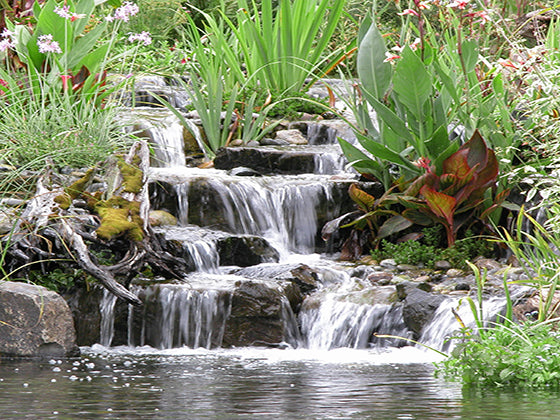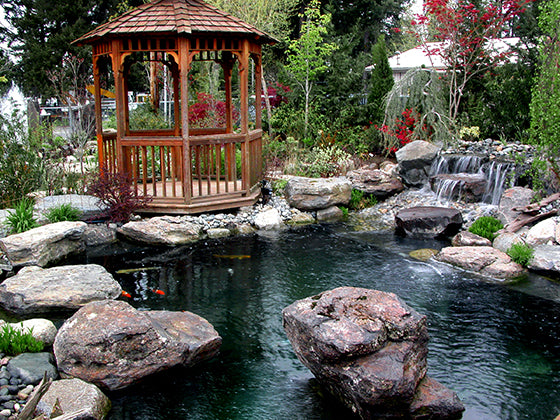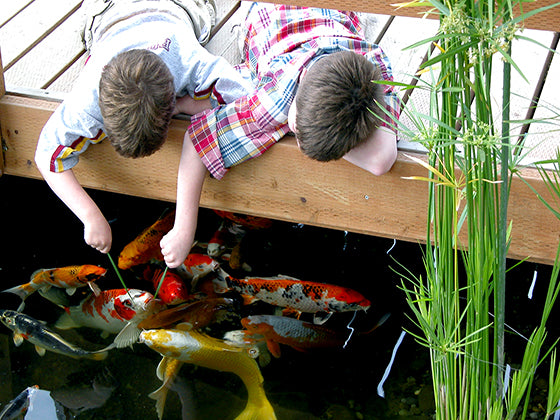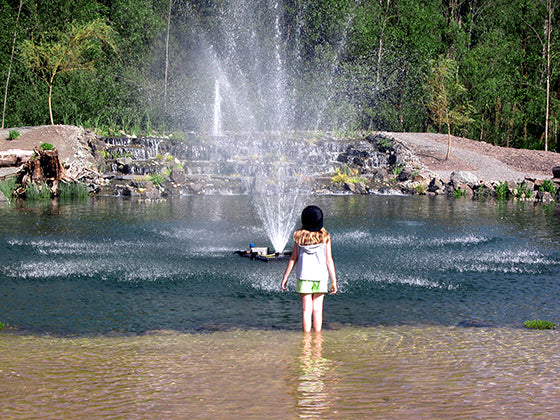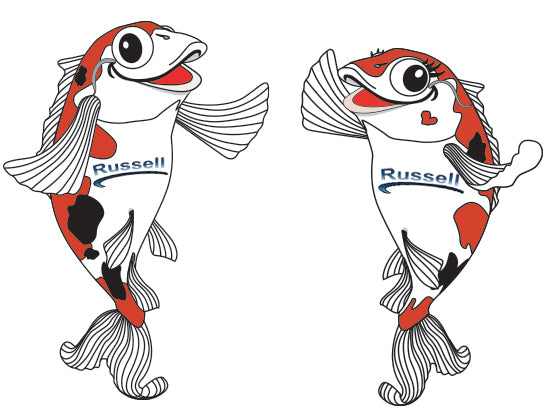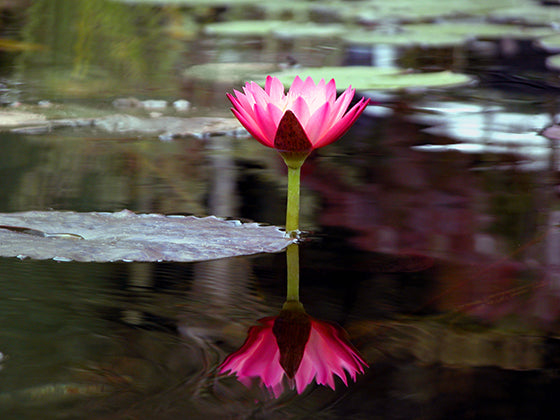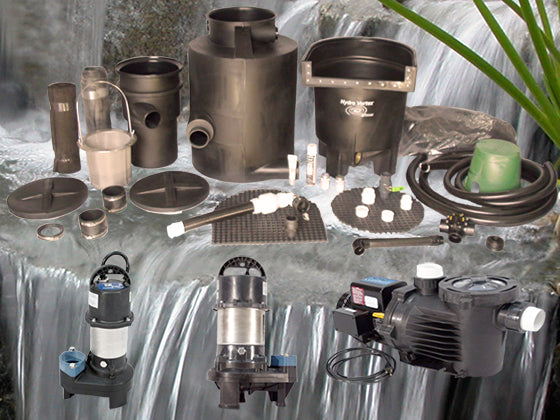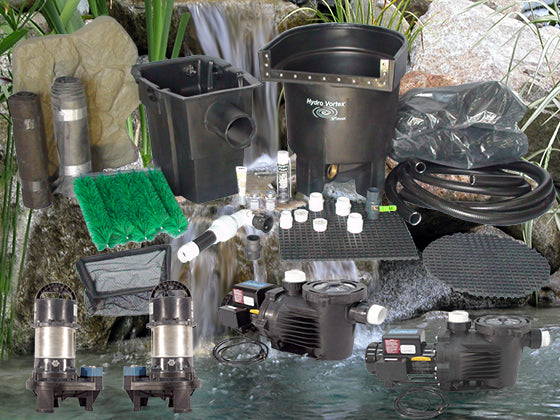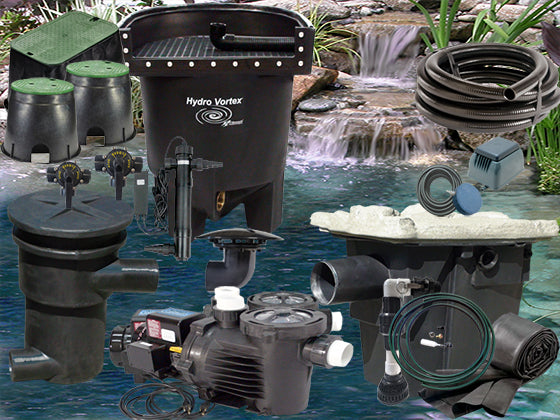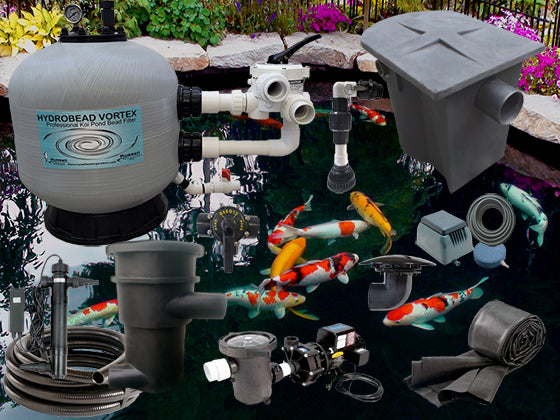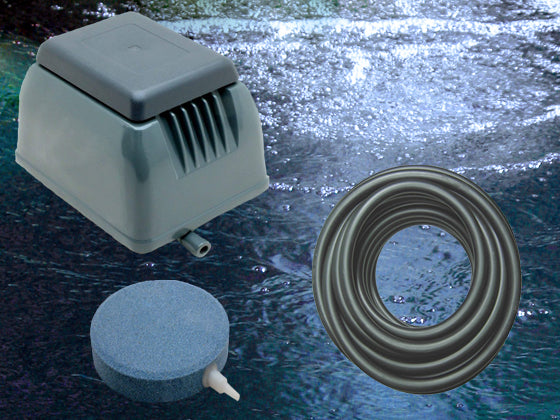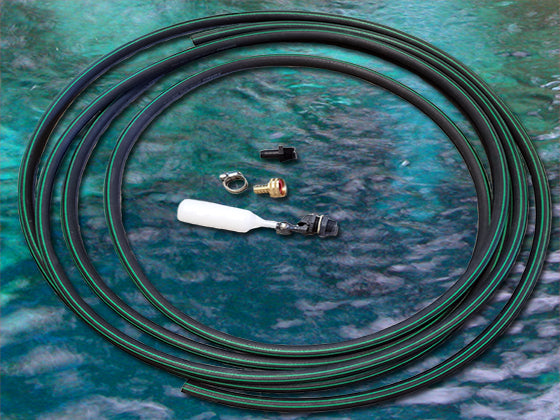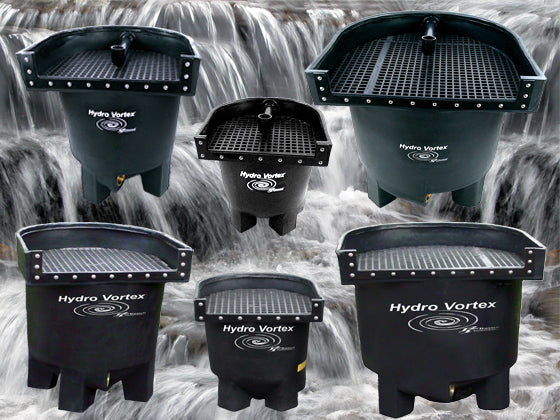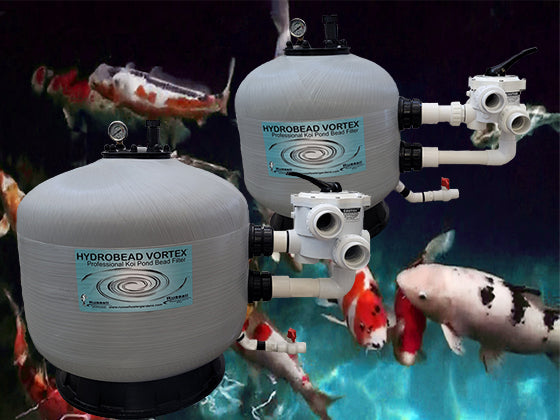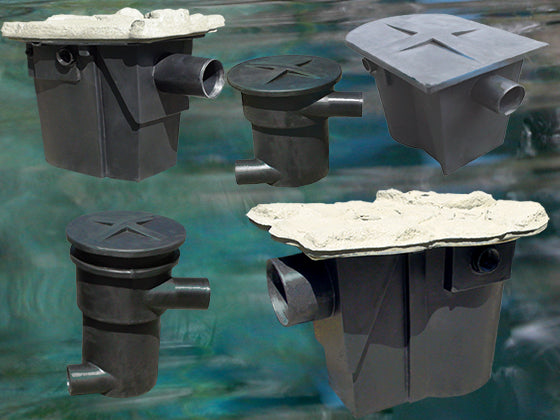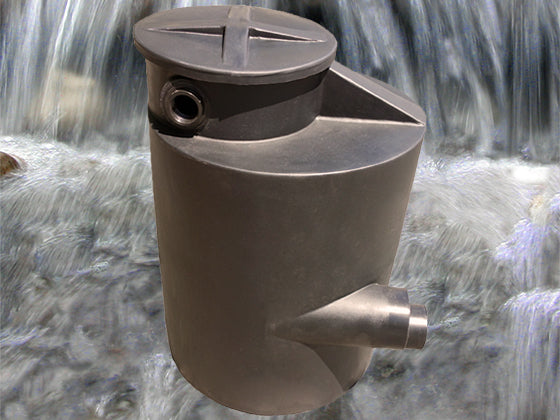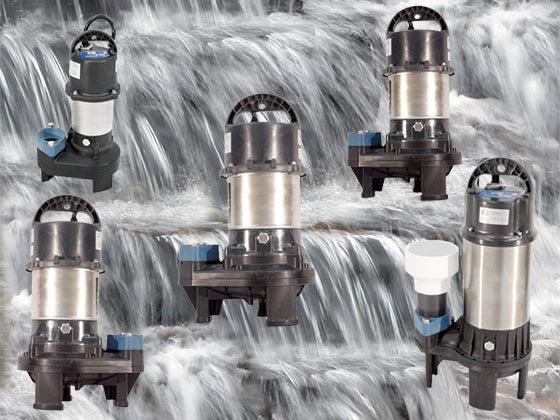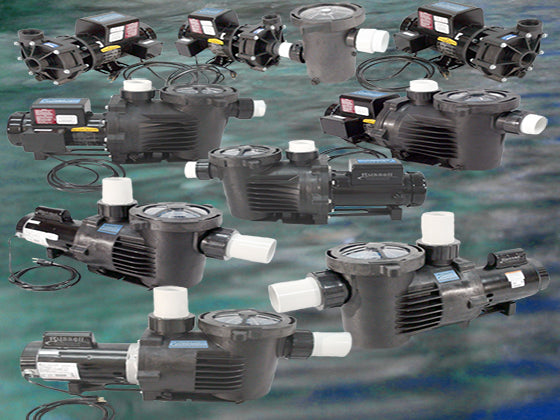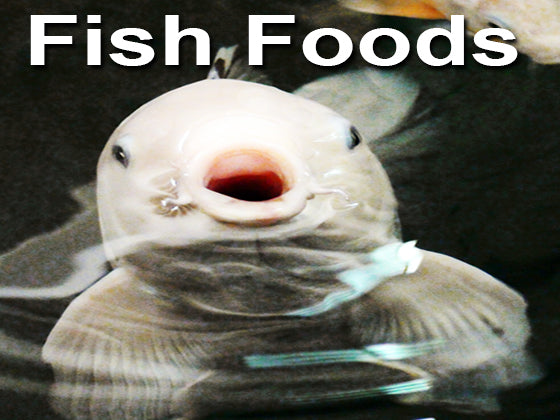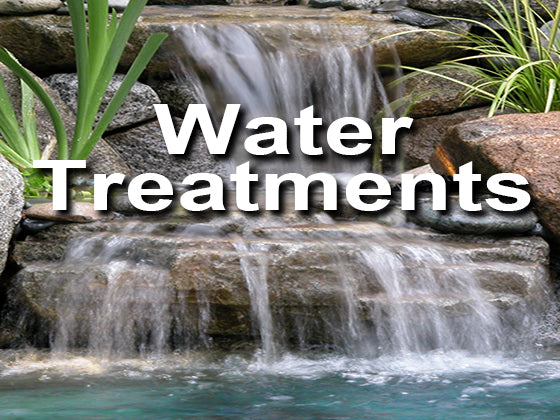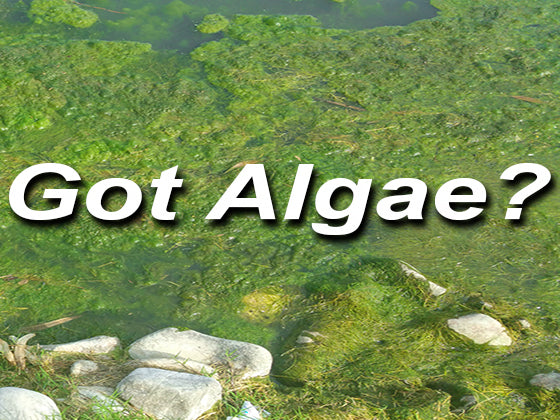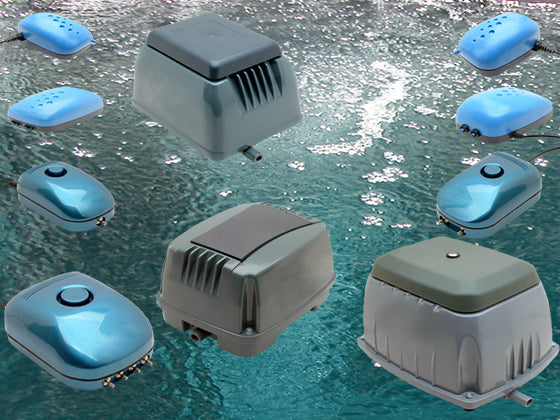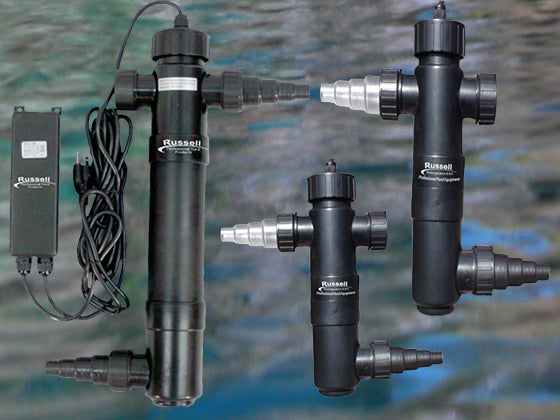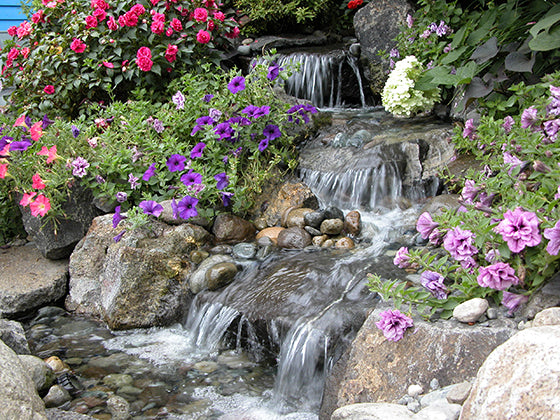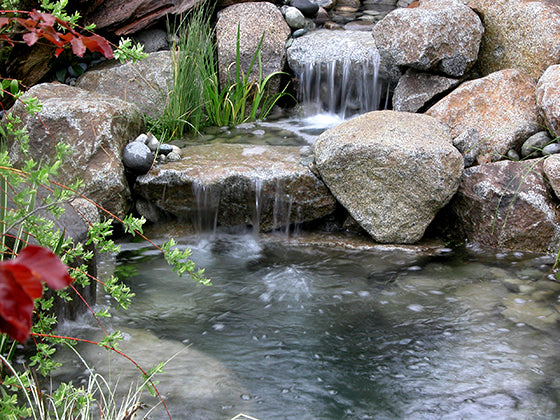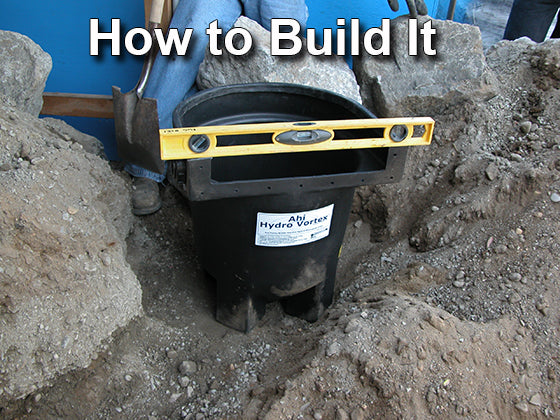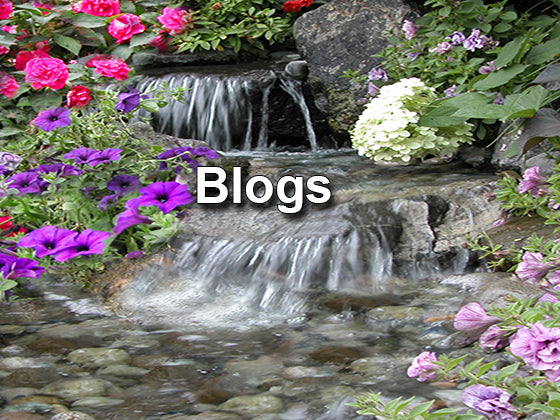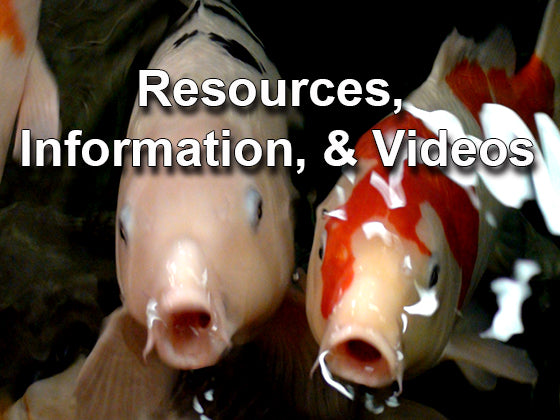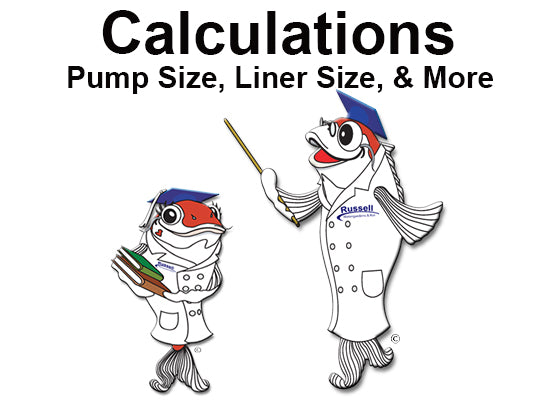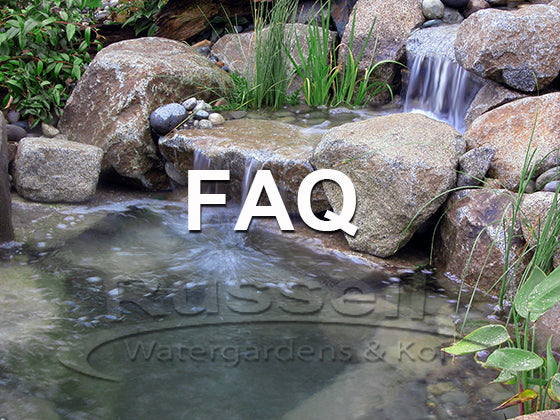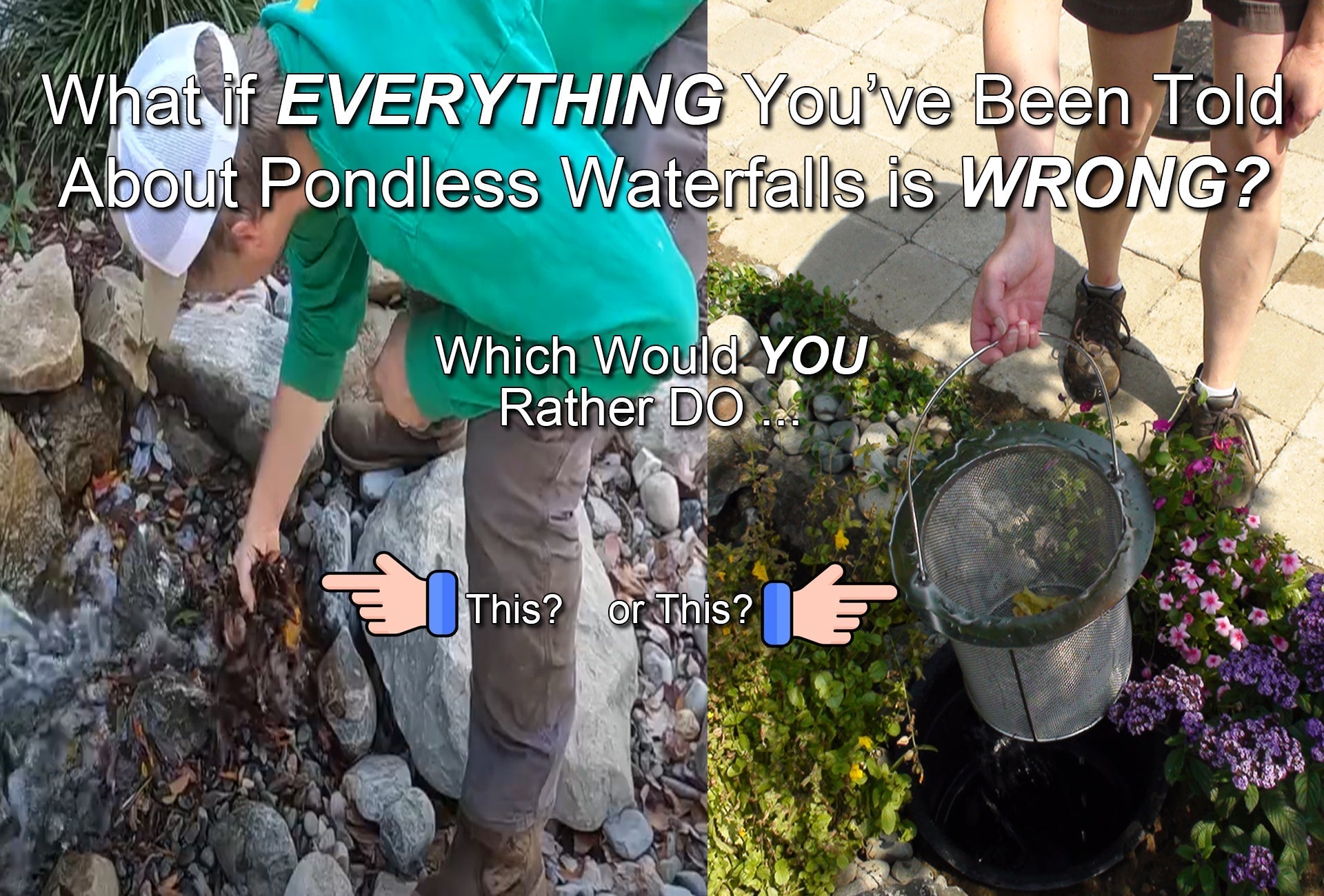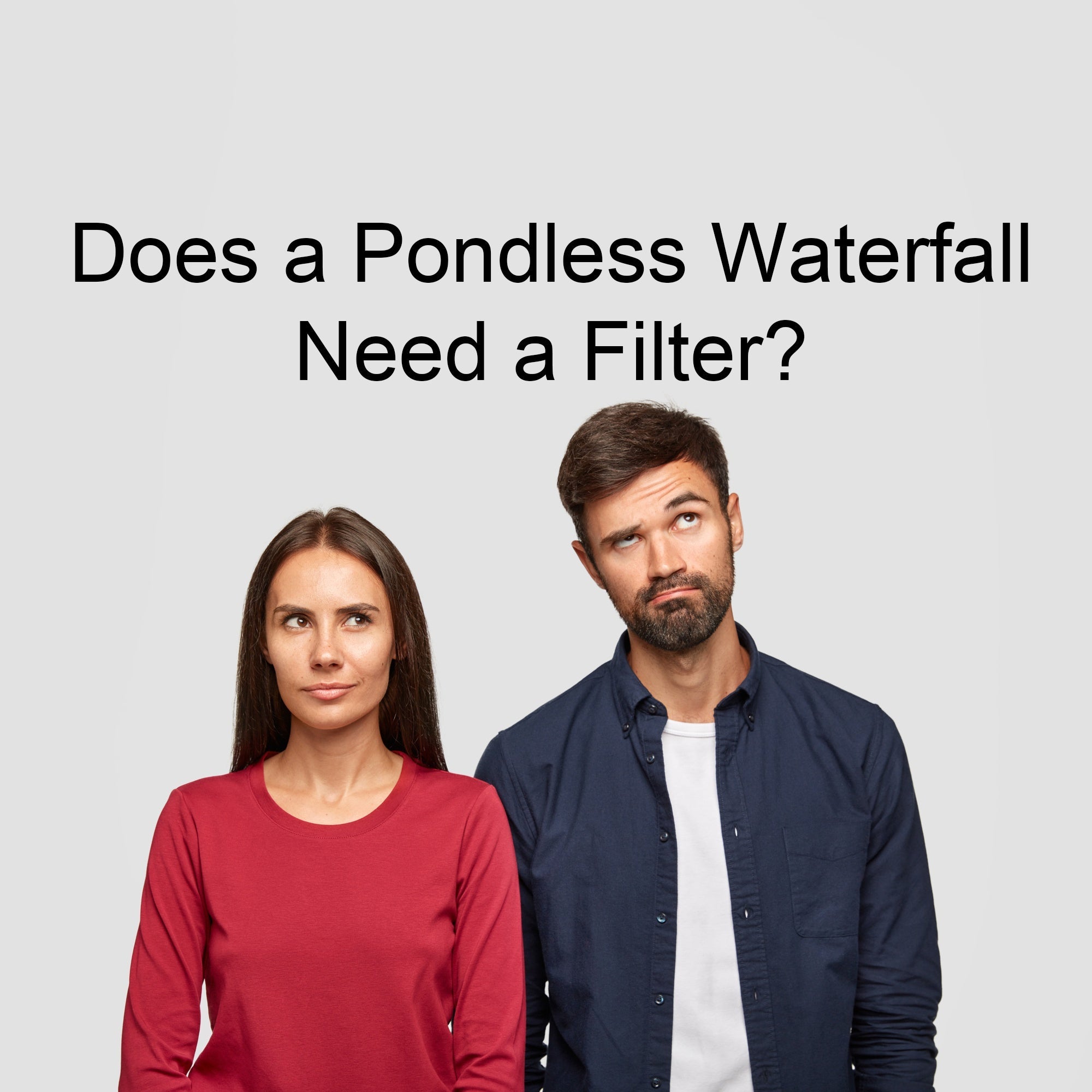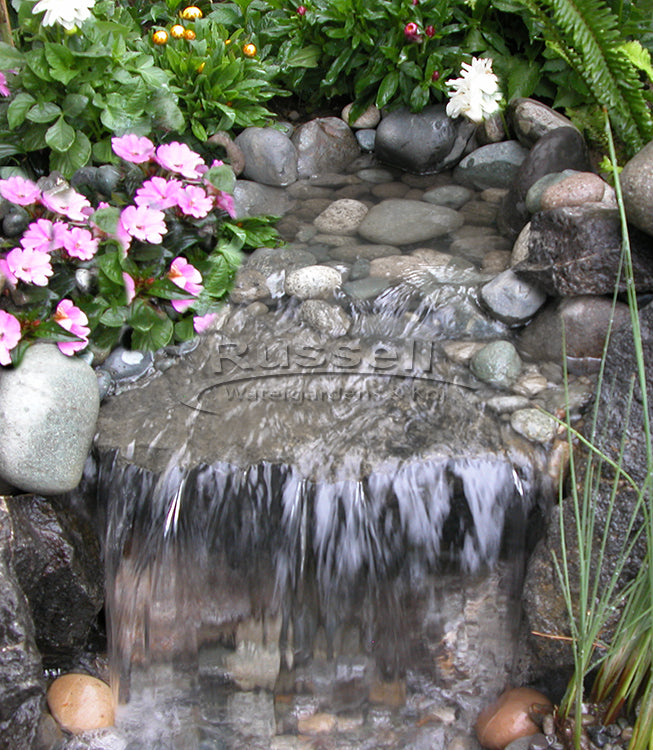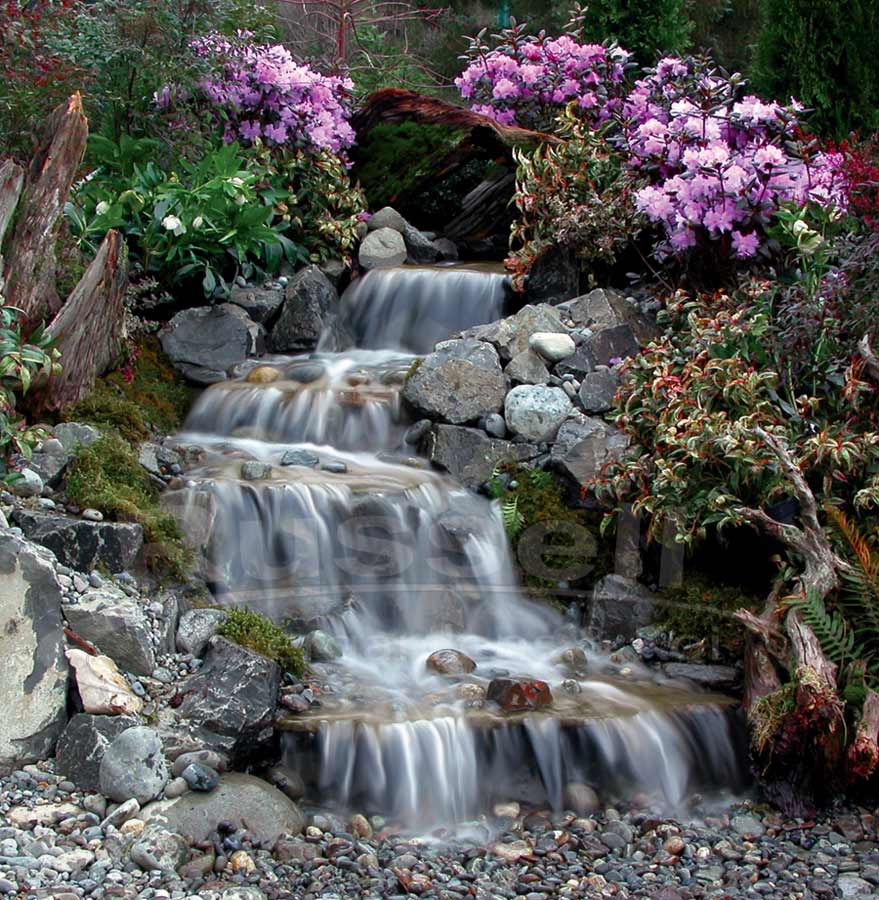FAQ - Frequently Asked Questions
FAQ
In business since 1997, we have years of experience answering questions, here are some of the most popular. If you have a question that is not answered here, give us a call, email, or Chat.
Shipping
Yes!
Yes!
Algae
Green water means that you have free floating algae in your pond water. The first thing to realize is that algae grows when it has a good food source and sunlight. So you have to fight green water algae two ways - kill it with an algaecide such as Algae-Fix or Tetra Pond Algae Control and then prevent it by using beneficial bacteria to break down the algae's food source. Every year start your biofilter with Nitrification Cycle bio-filter starter bacteria. Each spring add Spring Pond Starter to let the bacteria and liquid barley extract go to work breaking down algae food sources. Once the pond water starts to clear, you can switch to our more economical dry bacteria products such as Spring Maintenance, Summer Maintenance, and then Fall & Winter Maintenance when the temperatures drop.
For the brightest sunny days, use Hydro Shade Blue Pond Tint to shade your pond water blue to cut down on photosynthesis.
Another green water algae prevention device is a UV Clarifier. We have them in three sizes: 11 watt, 18 watt, and 36 watt.
Brown water in your pond usually means that there are tannins in the water. This comes from fallen leaves, twigs, or other organic materials that have been washed into the water. There are a few things you can do: Manually remove any twigs, leaves, or anything else that might be staining the water brown. If you have a pond skimmer, empty it regularly. If your biofilter is backwash-able, backwash your biofilter. Also, it will help if you change some of the pond water to flush out the dissolved tannins.
Once all that is done, we recommend our fast-acting liquid Spring Pond Starter™ to add beneficial bacteria and barley extract to the pond to start breaking down any organics that may not be visible. Once the water starts to clear, you can switch to either of our dry bacteria products Spring Maintenance™ or Summer Maintenance™.
Another thing to consider would be add Hydro Shade™ to tint the water blue to help reduce photosynthesis.
String, or 'blob' algae is growing because there are organics that are feeding it. Do NOT use an algaecide to kill big blobs of algae, as dead algae is just as ugly as live algae. Plus, dead algae will decrease dissolved oxygen in the water, and will feed even more algae.
So the first thing to do is to manually remove as much of the string, or blob algae as possible. Examine the algae up close, many times it will contain bits of leaves or other organic matter that is an indicator of what is feeding it's growth.
Manually remove any leaves, twigs, or other debris from your pond or waterfalls. Then add beneficial bacteria to begin the process of breaking down organics that feed your algae bloom.
Liquid Spring Pond Starter™ is the best place to start. Spring Pond Starter™ is live bacteria and barley extract. The bacteria and barley will go to work competing for food sources that would otherwise feed algae.
As the water temperatures warm up, you can switch to our more economical dry bacteria products: Spring Maintenance™, and Summer Maintenance™. When the water temperatures drop below 50 degrees, switch to Fall/Winter Maintenance™.
Once you have a significant amount of beneficial bacteria growing in your biological filter, you can start using small doses of algaecides like Algaefix or Tetra Pond Algae Control, and if you don't have fish, you can use Fountec.
To maintain your rocks and waterfalls clean and pristine, you can use Hydro Vescence™.
Pumps and Electrical
To know what size pump you will need for your waterfall, first you need to know the width of your waterfall, the height of your waterfall, and what type of stone will the water be falling off of.
A good starting point is to have a pump with a flow rate that is at least 100 gallons per hour per inch of waterfall width. For example, you have an 18" wide waterfall, that is 2' high, the pump should at least produce 1,800 gallons per hour (gph) at 2' high. You can increase, or decrease the flow rate to suite your needs. More water flow is louder than lower flow rates. So if you're in a quiet neighborhood, you could use a 1,200 gph pump, but if you have a lot of road noise, you could increase that flow rate to 2,400 gph.
Next, determine what type of stone the water will be falling off of. Smooth edge stone such as slate requires the least amount of flow rate. A jagged boulder waterfall would require a higher flow rate than the cut stone. A waterfall over rounded river rocks require an even higher flow rate to get the water to not hug the rounded stone.
Here are our guidelines when we are quoting a pump for your waterfall:
For cut stone waterfalls (such as slate) we recommend 100-150 gph per inch of waterfall width.
For jagged boulder waterfalls (such as quarry rock) we recommend 150-300 gph per inch of waterfall width.
For rounded boulder waterfalls (such as river boulders) we recommend 200-500 gph per inch of waterfall width.
Here at Russell Watergardens, we believe in providing choice and options. That is why we offer both types of pumps, submersible and external for every single one of our water garden, and hybrid pond kits, as well as pondless waterfall kits. Koi pond kits come with external pumps only.
A submersible pump is generally less expensive to purchase than an external pump, but costs more to operate. Submersible pumps are easier to install because they get installed inside a pond skimmer or pondless pump chamber. Submersible pumps have shorter warrantee periods than external pumps. Submersible pumps must always be connected to a GFCI protected circuit because the pump's electrical motor is underwater!
An external pump in generally more expensive to purchase than a submersible pump, but is drastically less expensive to operate as they are much more energy efficient. External pumps require additional plumbing because they are outside the pond skimmer or pondless pump chamber. External pumps have longer warrantee periods because they're not underwater. External pumps should also be connected to a GFCI protected circuit.
A short recap:
Submersible pump: Less expensive to purchase, more expensive to operate, easier to install, but has a shorter warrantee period.
External pump: More expensive to purchase, mush less expensive to operate, requires additional plumbing, and has a longer warrantee period.
Here is the math that lets you figure out the electrical cost of any electric device:
Amps x volts x 24 hours ÷ 1,000 x kilowatt cost x days in the month.
Or Watts x 24 hours ÷ 1,000 x kilowatt cost x days in the month.
For example a 3 amp 115 volt pump: 3 x 115 = 345 watts x 24 hours = 8,280 ÷ 1,000 = 8.28 kilowatts x 30 days = 248.40 monthly kilowatts ÷ $0.17 per kilowatt = $42.22 to run this pump 24 hours a day, 30 days per month.
Measure the distance between the elevation of where your pump will be installed and the height of your waterfall. Then add in 10% of the length of the pipe the water is pumped through.
We recommend a GFCI protected circuit and an outdoor, wet location type electrical box.
We do not recommend connecting your pump to an extension cord as it may damage the pump motor, or create a short and trip the GFCI breaker.
If you have a submersible pump the first thing to do is check the GFCI circuit breaker. If it is tripped, unplug your pump and reset the GFCI. Plug your pump back in. If the GFCI trips again, unplug it and to look to see if something is caught in the impeller. If the impeller isn't clogged and the GFCI still trips, that usually means there is water inside a submersible pump and will need to be replaced.
If your pump has stopped and the GFCI is not tripped check the inlet of the pump. Is it clogged with something? If so, remove the debris and see if the pump starts running. If it still doesn't run, check for an air-lock in the pump. Remove the check valve from the pump and turn your pump on. If there was an airlock in the pump impeller area or check valve running the pump by itself underwater will solve this issue.
If there is no airlock, nothing clogging the inlet, and not tripping the GFCI, the pump might be seized. This happens when a pump has operated dry. Pumping air instead of water will cause the pump to overheat and seize the bearings. The pump must be replaced.
If you have an external pump that stopped working check the GFCI circuit breaker. If it isn't tripped, check to see that the suction inlet side is primed with water and the inlet strainer is not clogged with debris. If the pump is self priming, check to see if there are any air leaks in the suction plumbing to the pump.
If it still isn't working, check to see if anything is causing the impeller to not turn.
If the pump still isn't working, it may be time to replace the pump.
The CVA in your kit was custom made to fit your pump. Thread the lower end with the male pipe adaptor of the CVA directly onto your submersible pump. Open the camlock at the top end. Thread the male part of the camlock into the female outlet port of your HydroClean™ pond skimmer or HydroChamber™ pondless pump vault. Then place the pump and CVA inside and re-connect the camlock male and female parts.
If your CVA was built for an external pump it will have a strainer at one end and the camlock at the other end. Simply disconnect the camlock, thread the male part directly into the HydroClean™ pond skimmer or HydroChamber™ pondless pump vault. Install the CVA with strainer inside and re-connect the camlock fittings and you're done!
Pipe and Liner Size Calculations
Size your pipe to the flow of your pump. Pipe size is determined by the maximum flow rate that will go through it. Here are the maximum water flow for the size of pipe:
1/2" pipe = 480 maximum gph
3/4" pipe = 900 maximum gph
1" pipe = 1,500 maximum gph
1 1/4" pipe = 2,700 maximum gph
1 1/2" pipe = 3,600 maximum gph
2" pipe = 5,400 maximum gph
3" pipe = 13,500 maximum gph
4" pipe = 21,000 maximum gph
6" pipe = 42,000 maximum gph
Calculating liner size is pretty simple:
Width plus 2X Depth, plus Length plus 2X Depth plus 2 for Overlap.
We show you how to calculate your ideal liner size for all types of ponds, waterfalls, and streams.
To calculate your pond liner size for any type of pond:
Measure your widest WIDTH
Measure your longest LENGTH
Measure your deepest DEPTH
Add Safety Overlap of 1' on each side of pond - or simply 2' to each dimension.
Example: Your pond is going to be 17' long by 12' feet wide, with a maximum depth of 2'.
Add "Double your Depth" to each dimension to accommodate the vertical walls in the pond. (2 x 2 = 4) So the dimensions adjusted for depth are now 21' long and 16' wide. (17 + 4 = 21 and 12 + 4 = 16)
Now add a "Safety Overlap" of 2' to each of those dimensions. (21 + 2 = 23, and 16 + 2 = 18). Your 17' long by 12' wide pond with a 2' depth and 1' of Safety Overlap on each side would need a 23' x 18' liner.
Liner is sold in 5' increments - so you would purchase a 25' x 20' liner for this pond.
Pondless Waterfalls
To calculate the water storage you will need for your pondless waterfall you will need to know the width, length, and depth of your stream. Include the height of your waterfall to the total length of stream.
For example the waterfall and stream you want to build is 2' high by 2' wide by 10' long by 2" deep.
Here is the math: 2' + 10' x 2' ÷ 6 = 4 cubic feet of water. There are 7.48 gallons of water per cubic foot. 4 x 7.48 = 29.92 gallons of water in your waterfall and stream.
Another example: 18" high waterfall into and 18" wide stream that is 5' long and 1.5" deep.
Here is the math: 1.5' + 5' x 1.5' ÷ 8 = 1.21 cubic feet of water.
7.48 x 1.21 = 9.05 gallons in this smaller waterfall and stream.
Each Hydro Chamber™ holds 50.87 gallons of water above the pump - 75 gallons total. One Hydro Chamber™ will work with each of these examples. Hydro Chambers™ daisy-chain together for unlimited water storage.
We are so glad you asked! Our Ultimate Pondless Waterfall Kits are the only pondless waterfall kits that come complete with a double patented Hydro Vortex™ backwashable waterfall filter, an easy to clean Hydro Sieve™ pre-filter, and an easy to install Hydro Chamber™ that replaces slotted pump vaults, two matrix blocks, liner, underlayment, and tons of rock. The Hydro Chamber™ is also pre-plumbed for an auto water fill valve, and each kit comes with choice of submersible and external pumps. All piping is professional flexible PVC pipe and Schedule 40 PVC fittings. Both the Hydro Sieve™ and the Hydro Chamber™ can be remotely installed away from your pondless waterfall. No other brand of pondless waterfall comes complete with all these features.
Does a pondless waterfall need a filter?
Compare Pondless Waterfall Kits
Pondless Waterfall Design Ideas
Compare the Hydro Chamber to slotted pump vaults
Go ahead and Google pondless waterfall kits. Take a good look at all of them. They are essentially all the same with varying prices. Many don't include a waterfall filter, just a waterfall starter that doesn't filter anything. Most use cheaper and prone to cracking Kink-Free tubing instead of flexible PVC. All of them use a slotted pump vault. Some include matrix block. None of them come with an easy to clean pre-filter. The rock and gravel acts as the pre-filter - but how do you clean the gravel? When shopping for pondless waterfall kits, do yourself a favor and ask: "How do I clean this pondless waterfall kit?".
The Hydro Sieve™ and Hydro Chamber™ will always get installed parallel to the lowest elevation of your pondless waterfall.
Remotely installing your Hydro Sieve™ and Hydro Chamber™ with 4" pipe depends on the flowrate of your pump.
Here are our guidelines for remotely installing your Hydro Sieve™ pre-filter and Hydro Chamber™ with 4" pipe:
1,800 gph pump flow rate ÷ 500 = 3.6' maximum distance.
2,700 gph pump flow rate ÷ 500 = 5.4' maximum distance.
3,500 gph pump flow rate ÷ 500 = 7' maximum distance.
4,700 gph pump flow rate ÷ 500 = 9.4' maximum distance.
Here are our guidelines for remotely installing your Hydro Sieve™ pre-filter and Hydro Chamber™ with 6" pipe:
5,000 gph pump flow rate ÷ 600 = 8.3' maximum distance.
6,000 gph pump flow rate ÷ 600 = 10' maximum distance.
7,000 gph pump flow rate ÷ 600 = 11.6' maximum distance.
The Hydro Chamber™ has a 4" nipple at the bottom of the tank. Use a 4" rubber coupler to connect the tanks to each other. If you want to connect three or more Hydro Chambers™, you will use a 4" tee between the bottom 4" nipples.
The Hydro Chamber's™ coupling nipple is not normally open. If you order two or more from us, we will cut the nipples open for you. If you prefer to do it yourself, Simply cut the end of the nipple off.
You can connect the Hydro Chambers™ directly to each other side by side, or using 4" pipe and an extra 4" rubber coupler you can connect the Hydro Chambers apart from each other.
If you have one of our Ultimate pondless waterfall kits, winterizing is super easy.
1. Open the bottom drain valve of the Hydro Vortex™ waterfall filter.
2. If you opted for the HydroFlush™ Backwash System turn the valve to backwash.
3. Turn your pump on. The HydroFlush™ will backwash the filter while draining the Hydro Chamber™. If you don't have the HydroFlush™ Backwash System, simply let the pump empty the Hydro Chamber™ out of the Hydro Vortex™ filter's drain valve.
4. Remove the pump and store in a dry location indoors.
5. Leave the Hydro Vortex™ bottom drain valve open.
6. Install a rubber cap on the Hydro Sieve's inlet pipe to prevent rain water from entering.
That's it!
With our Ultimate pondless waterfall kits, the maintenance is super easy. Simply empty the HydroSieve™ pre-filter basket at least weekly and backwash your Hydro Vortex™ waterfall filter at least monthly.
Since there are no fish in the water producing ammonia, products like Nitrification Cycle™ are not required. We simply recommend using HydroClear™ Summer Maintenance bacteria to break down dissolved organics and periodic use of Hydro Vescence™ rock cleaner.
Annual maintenance supplies can be under $50.00 depending on the total size of your pondless waterfall.
Other pondless waterfall kit companies use large excavations filled with underlayment, rubber liner, slotted pump vault, and tons of rock. Some pondless waterfall kits come with matrix blocks, and others simply use milk crates covered with rock and gravel.
That is why they recommend such large capacity storage basins - the basin is filled with rocks and gravel. The actual water storage is between the rocks and gravel.
That is why our Ultimate pondless waterfall kits are so unique! Water disappears into the Hydro Sieve™ pre-filter, and then into the Hydro Chamber™. The pondless waterfall basin excavation is much smaller with a Hydro Chamber™ than a giant excavation filled with rocks and gravel. Ultimate pondless waterfall kits are also much easier to clean. There is no need to hand pick debris from the rock and gravel basin.
Water Treatments for Ponds and Pondless Water Features
The active ingredients in Hydro Vescence™: Sodium Carbonate and Hydrogen Peroxide – Na2CO2 & H2O2.
All natural oxygen based pond and rock cleaner for all types of ponds, waterfalls, streams, rock columns, fountains, and water features. Safe for ponds with fish.
Liquid bacteria goes to work faster. Dry bacteria takes a little longer, but is less expensive per dose.
Nitrification Cycle is a fast acting liquid formulation to get your biological filter up and running comparatively quicker than dry bacteria.
Spring Pond Starter is a liquid beneficial bacteria plus liquid barley straw extract. This is designed to "jump start" your pond in the spring. The bacteria go to work doing their thing breaking down ammonia and other organics, while the liquid barley helps improve pond water quality and clarity while helping buffer pond water and creates a mature ecosystem rather quickly.
Dry bacteria work exactly the same as the liquid bacteria, it just takes a few weeks longer. Dry bacteria is less expensive per dose than the liquids.
We recommend starting your biofilter with Nitrification Cycle. In the early spring months, we recommend Spring Pond Starter to get the ecosystem up and running. Then later in the spring switch to Spring Pond Maintenance to maintain the ecosystem. As the pond water warms in the summer season, we recommend switching to Summer Maintenance. Lastly, as the water temperatures fall in the fall and winter months, switch to our Fall and Winter Maintenance sinking pellet beneficial bacteria that go to work breaking down organics from the bottom of your pond through the winter months.
- Nitrification Cycle™ contains live Nitrosomonas, Nitrobacter, and Nitrospira bacteria strains
- Metabolizes ammonia into nitrite, and nitrite into nitrate
- Bio-filter starter and spring start-up bacteria
- Highly concentrated formula at over 1.5 billion bacteria per ounce
- Seeds and maintains biological filters
Nitrifying beneficial pond bacteria is a critical component to all biological pond filters. Without nitrifying beneficial pond bacteria, a biological filter is not “biological”. A biological filter is essential for maintaining a healthy ecosystem to support fish and other aquatic life. Fish and aquatic life release ammonia into the water that is toxic to the fish. Without beneficial bacteria inside a biological fish pond filter, the water will become unhealthy for your koi and pond fish.
The nitrification cycle is the conversion of ammonia to nitrite, and then nitrite to nitrate with specific bacteria. Nitrification Cycle™ Nitrifying Pond Bacteria contains those specific bacteria critical for the nitrification cycle in biological fish pond filters.
HydroClearNitrification Cycle™Nitrification Cycle™ Nitrification Cycle™ beneficial pond bacteria reduces ammonia, fish waste, organic plant material, sludge, and excess nutrients in your pond. High concentration for optimum results.
The nitrogen cycle is the biochemical cycle by which nitrogen is converted into multiple chemical forms as it circulates through aquatic ecosystems. The conversion of ammonia to nitrite, and nitrite to nitrogen is carried out through the biological filters' process.
Spring Starter™ Bacteria Plus Barley contains:
- Heterotrophic beneficial pond bacteria
- Natural clarifying barley straw extract
- Naturally clears water
- Controls problem causing phosphate
- Reduces murky water
- Reduces pond water odor
- Promotes clean, clear, healthy pond water
- Promotes fish health
- Metabolizes fish waste
- Metabolizes problem causing fallen tree leaves and twigs
Spring Maintenance is a dissolvable salt powder that is a highly concentrated formula containing billions of beneficial bacteria per gram combined with pulverized barley.
- Heterotrophic beneficial pond bacteria
- Natural water clarifying pulverized barley
- Naturally clears water
- Controls water problem causing phosphate
- Reduces murky water
- Reduces pond water odor
- Promotes clean, clear, healthy water
- Promotes fish health
- Metabolizes fish waste
- Metabolizes water problem causing fallen tree leaves and twigs
- Metabolizes water problem causing sludge and muck
- Metabolizes water problem causing proteins, cellulose, carbohydrates, and lignin
Summer Maintenance ingredients are a proprietary blend of 5 bacteria strains; Bacillus subtilis, Bacillus licheniformis, Bacillus amyloliquefaciens, Bacillus megaterium, and Bacillus pumilus bacteria that produce multiple enzymes.
HydroClear™ Spring Maintenance™ is recommended for use during the spring season – typically from March through June. The bacteria, and the enzymes they produce go to work breaking down pollen, dust, grass clippings, leaves, and other wind blown debris commonly associated with the spring season.
The all natural pulverized barley straw aids in clarifying water naturally. The pulverized barley straw contained in Spring Maintenance™ eliminates the need for barley straw, liquids, or pellets to gain the benefits of natural barley. It is a true “3-in-1” product.
The bacteria strains produce enzymes that metabolizes water problem causing proteins, cellulose, carbohydrates, and lignin: Protease, Amylase, Ligninase, Lipase, Esterase, Cellulase, Xylanase, and Urease enzymes. Summer Maintenance contains no fillers, has no unpleasant odor, and is all natural, no chemicals, no artificial fillers or preservatives.
Fall Winter Maintenance is a dissolvable compressed salt powder block that is a highly concentrated formula containing billions of beneficial bacteria per gram. Fall Winter Maintenance ingredients are a proprietary blend of 5 bacteria strains; Bacillus subtilis, Bacillus licheniformis, Bacillus amyloliquefaciens, Bacillus megaterium, and Bacillus pumilus bacteria that produce multiple enzymes.
- Heterotrophic beneficial pond bacteria in ⅓ oz. blocks new improved size increases coverage
- Naturally clears water
- Controls water problem causing phosphate
- Reduces murky water
- Reduces pond water odor
- Promotes clean, clear, healthy water
- Promotes fish health
- Metabolizes fish waste
- Metabolizes water problem causing fallen tree leaves and twigs
- Metabolizes water problem causing sludge and muck
- Metabolizes water problem causing proteins, cellulose, carbohydrates, and lignin
The bacteria strains produce the enzymes that metabolizes water problem causing proteins, cellulose, carbohydrates, and lignin: Protease, Amylase, Ligninase, Lipase, Esterase, Cellulase, Xylanase, and Urease enzymes. Summer Maintenance contains no fillers, has no unpleasant odor, and is all natural, no chemicals, no artificial fillers or preservatives.
Fall and Winter Maintenance ingredients are the same as Summer Maintenance, just compressed into blocks instead of a powder to ensure they sink to the bottom of your pond to get to work breaking down sunken organics.
Fall-Winter Maintenance™ cold water pond bacteria is recommended for use during the fall and winter seasons – typically from September through March. The bacteria, and the enzymes they produce go to work breaking down fallen leaves and other wind blown debris commonly associated with the fall and winter seasons.
Fall-Winter Maintenance™ is also recommended for use in pondless waterfalls to help keep them clean, fresh smelling, and to help prevent algae growth.
Pond Types
There are a lot of pond supply companies that market their water garden pond kits as koi pond kits. Go ahead and Google koi pond kits - you will find that almost every single pond kit that pops up is a water garden pond kit. It drives us crazy when they false market that way. It is a disservice to you the customer. A water garden pond is completely different than a koi pond, and the respective pond kits are completely different too.
A water garden pond has a maximum depth of 2' while a koi pond has a minimum depth of 3'.
A water garden pond is excavated with two or three steps to create a marginal plant shelf, followed by a lily shelf, then down to the maximum depth of 2' in the center of the pond. This, unfortunately makes it easy for herons and raccoons to catch and eat your fish. A koi pond has straight down sides to prevent predators from walking into the pond and catching your koi.
A water garden pond uses boulders inside the liner to retain the earth. Koi ponds retain the earth behind the liner with building materials such as concrete, brick, or treated timbers.
A water garden pond has gravel over all of the liner. Koi ponds have smooth bare liner bottoms. Water gardens do not have a bottom drain. Koi ponds do have a bottom drain. Water garden ponds have a pond skimmer and a waterfall filter. Koi ponds have a pond skimmer, a bottom drain, a bottom drain pre-filter, an external pump, external aeration, and a backwashable koi pond filter.
In simple terms, a water garden pond is nothing like a koi pond. Do not let false online marketing fool you. If you truly want a koi pond, make sure it is an actual koi pond kit.
Here at Russell Watergardens & Koi, we offer water garden pond kits, koi pond kits, and hybrid pond kits. This ensures you get the exact pond you are envisioning.
Click on the tab "Styles" in the upper navigation links and then "Pond Styles" to see diagrams of each pond style.
A hybrid pond is part water garden pond, and part koi pond. It was invented by John Russell based upon the revolutionary Hydro Vortex™ backwashable waterfall filter. You can not have a hybrid pond without a backwashable waterfall filter.
A hybrid pond has a minimum depth of 3'.
Similar to a water garden pond, a hybrid pond has boulders on the inside of the pond to retain the earth. Similar to a koi pond, a hybrid pond has a smooth bare liner bottom sloped towards a bottom drain. Similar to a water garden pond, a hybrid pond has aquatic plants, but only on one single perimeter marginal shelf, then straight down sides from there. But with no gravel on the liner, all aquatic plants are in baskets. Similar to a koi pond, the hybrid pond has a bottom drain and a bottom drain pre-filter. Similar to a koi pond, a hybrid pond has external supplemental aeration, and a UV system.
A hybrid pond looks more natural in the landscape than a koi pond, but is much safer and healthier for raising koi than a water garden pond.
Click on the tab "Styles" in the upper navigation links and then "Pond Styles" to see diagrams of each pond style.
A crossover pond is part hybrid pond, and part koi pond. Like a hybrid pond, a crossover pond has boulders, but only on the aquatic plant shelf around the perimeter. Also like a hybrid pond, there is no gravel on the horizontal surfaces so all aquatic plants are in baskets. Like a koi pond, the earth is retained behind the liner with building materials. A crossover pond is like a koi pond with depths to 8'. Crossover ponds are typically larger and deeper than hybrid ponds, and we also refer to a crossover pond as a swimming pond because you can swim in them with your fish!
The filtration system of a crossover pond is the same as a hybrid pond, the only difference is the depth, the construction materials, and the construction technique. A hybrid pond has boulders inside the liner all the way down to the bottom. A crossover pond only has boulders on the aquatic plant shelf. Then straight down sides to the bottom by retaining the earth behind the liner with building materials.
Click on the tab "Styles" in the upper navigation links and then "Pond Styles" to see diagrams of each pond style.
The first thing to realize, is that it is not about the number of fish in your pond, but the type, size, and weight of your fish. Goldfish get to a certain size and stop growing, but koi keep growing and growing. The bigger they get, the more they poop.
You also need to consider your mechanical and biological filtration. You want your mechanical filtration to remove all solids before the biological stage. You will need to know the total SSA of your biofilter. SSA means Specific Surface Area for beneficial bacteria to grow. The more surface area, the more beneficial bacteria. The more beneficial bacteria, the more ammonia and dissolved organics are metabolized out of the water.
Don't be fooled by simple "rules of thumb" you find online. If you overstock your pond or filtration system you will have sick fish.
We use SSA to tell you have much fish by weight each of our biological filters can process. You must couple that figure with your total water volume. More water, more fish. Less water, less fish.
For an example the Marlin Hydro Vortex™ biological waterfall filter supports up to 1,706 grams of fish weight in 2,000 gallons of pond water. Then simply go to our handy Koi Length and Weight chart under the Resources and Information tab to see what that translates into.
The amount of fish you can safely have in your pond also relates to your maintenance practices. If you have Easy to Clean equipment lithe the Hydro Sieve™ bottom drain pre-filter, or a HydroClean™ pond skimmer, coupled with a fully backwashable Hydro Vortex™ waterfall filter or HydroBead Vortex™ koi pond filter, your maintenance will be much easier and quicker, and therefor you are more likely to perform them on a regular basis. Filtration systems that are difficult to clean often get put off because it is very time consuming and unpleasant. Cleaning your filtration equipment regularly can result in the ability to support higher fish loads healthily.
The more regular maintenance you perform on your pond, the less pond supplies you will need to maintain it. Clean your HydroClean™ pond skimmer's leaf net and brush rack or Sieve basket at least weekly. Backwash your Hydro Vortex™ filter or HydroBead Vortex™ koi pond filter at least monthly. With those small chores done, simply start your filter with Nitrification Cycle. Then start you pond with Spring Pond Starter, then maintain the pond with either Spring Pond Maintenance, or Summer Maintenance. In winter, switch to Fall Winter Maintenance.
The typical pond will use one bottle of each product and be under $200 per year of maintenance supplies.
Equipment
Our patented Hydro Vortex™ waterfall filters are used for both ponds and pondless waterfall installations.
For pondless waterfalls: Hydro Vortex™ waterfall filters have three different waterfall widths, match the Hydro Vortex™ filter to your waterfall design width.
Ahi Hydro Vortex™ waterfall filter features a 16" wide waterfall opening.
Marlin Hydro Vortex™ waterfall filter features a 20" wide waterfall opening.
Dolphin Hydro Vortex™ waterfall filter features a 25" wide waterfall opening.
For ponds: Hydro Vortex™ waterfall filters are in three sizes for the volume of water in your pond
Ahi Hydro Vortex™ waterfall filter is for ponds up to 1,000 gallons.
Marlin Hydro Vortex™ waterfall filter is for ponds up to 2,000 gallons.
Dolphin Hydro Vortex™ waterfall filter is for ponds up to 4,000 gallons.
We're so glad you asked! John Russell invented and designed Hydro Vortex™ filters for the specific purpose of being easy to clean. Hydro Vortex™ waterfall filters are designed to be cleaned without disassembly unlike all other brands of waterfall filters on the market.
To manually backwash a Hydro Vortex™ waterfall filter:
1. Turn your pump off.
2. Open the drain at the bottom backside of the Hydro Vortex™ filter and let it completely drain.
3. In pondless applications, simply use a garden hose to rinse water into the top of the Hydro Vortex™ waterfall filter. Squirt the top grate and any rocks on top down through the filter media.
4. When the water coming out the drain runs clear your done! Close the drain valve and restart your pump.
5. For pond applications use a small pump and hose to pump pond water down through the Hydro Vortex™ filter as to not harm the beneficial bacteria with chlorinated water.
If you opted for the HydroFlush™ Backwash System:
1. Turn your pump off.
2. Open the drain at the bottom backside of the Hydro Vortex™ filter and let it drain completely.
3. Turn the HydroFlush™ valve to the Backwash position.
4. Turn your pump back on. Water will shoot upwards over the top opening of the Hydro Vortex™ waterfall filter. The water will fall back down rinsing the filter down through the bottom drain.
5. When the water running out of the drain runs clear your done! Close the bottom drain valve, and turn the HydroFlush™ valve to the Filter position and restart your pump.
No! The Hydro FilterSilk™ bio media inside the Hydro Vortex™ filter is HDPE High Density Polyethylene thermoplastic netting. The Hydro Vortex™ filter is designed for routine backwashing. With regular backwashing the netting will not need to be replaced.
But, if you don't regularly backwash your Hydro Vortex™ filter as it is designed to be, the FilterSilk, as with any filter media, can clog over time.
Our HydroClean™ pond skimmers are sized for the maximum water flow rate that passes through them.
The Hydro Sieve™ Satellite pond skimmer is designed for a total maximum flow rate of 3,500 gph (58 gpm) with one 4" outlet nipple.
The Seagull HydroClean™ pond skimmer is designed for up to two pumps with a total maximum flow rate of 3,500 gph (58 gpm) with three interchangeable 1½" outlet ports.
The Piper HydroClean™ pond skimmer is designed for up to two pumps with a total maximum flow rate of 7,000 gph (117 gpm) with three interchangeable 2" outlet ports.
The Pelican HydroClean™ pond skimmer is designed for up to two pumps with a total maximum flow rate of 15,000 gph (250 gpm) with three interchangeable 3" outlet ports.
Each model of HydroClean™ Pond Skimmer and Pre-Filter connects directly to 4", 6", or 10" PVC or ABS piping with a rubber coupler. Super easy! Installing your pond skimmer away from the pond makes for a much prettier and natural looking pond.
Installing HydroClean™ pond skimmers or a HydroSieve™ pre-filter away from the pond or pondless waterfall is easy to do, and makes for a much more natural looking pond or pondless waterfall. Flow rate and pipe size determine the maximum distance we recommend for remote installation.
Through testing we have found equations that make determining pipe distance easy.
4" pipe we divide the pump's flow rate by 500.
6" pipe we divide the pump's flow rate by 600.
10" pipe we divide the pump's flow rate by 1,000.
For our Seagull and Hydro Sieve™ units that use 4" pipe:
1,500 gph pump rate ÷ 500 = 3' maximum with 4" pipe.
2,700 gph pump rate ÷ 500 = 5.4' maximum with 4" pipe.
3,600 gph pump rate ÷ 500 = 7.2' maximum with 4" pipe.
For our Piper HydroClean™ pond skimmer with 6" pipe:
5,000 gph pump rate ÷ 600 = 8.33' maximum with 6" pipe.
6,000 gph pump rate ÷ 600 = 10' maximum with 6" pipe.
7,000 gph pump rate ÷ 600 = 11.66' maximum with 6" pipe.
For our Piper HydroClean™ pond skimmer with 4" pipe:
1,800 gph pump rate ÷ 500 = 3.6' maximum with 4" pipe.
2,700 gph pump rate ÷ 500 = 5.4' maximum with 4" pipe.
3,500 gph pump rate ÷ 500 = 7' maximum with 4" pipe.
4,700 gph pump rate ÷ 500 = 9.4' maximum with 4" pipe.
For our Pelican HydroClean™ pond skimmer with 10" pipe:
10,000 gph pump rate ÷ 1,000 = 10' maximum with 10" pipe.
12,000 gph pump rate ÷ 1,000 = 12' maximum with 10" pipe.
15,000 gph pump rate ÷ 1,000 = 15' maximum with 10" pipe.
We have two versions of the Hydro Sieve™. One is a satellite pond skimmer, the PF version is for pre-filtering bottom drains and pondless waterfalls. They both feature a stainless steel mesh filter basket to trap debris. The PF version has an additional stainless steel micro filtering layer for complete debris removal.
They both feature 4" inlet and outlet. Water enters the unit parallel to the radius to force the water into a swirling vortex that increases debris capture.
With regular backwashing, no. When installed as directed behind a pre-filter so that no organic debris enters the HydroBead Vortex™ koi pond filter, with regular backwashing, the Styrofoam beads inside the HydroBead Vortex™ koi pond filter never rot or decay.
If not regularly backwashed, the Styrofoam beads may compress. If that happens, drain the filter and use a butter knife to break apart any beads that have compressed. If left un-backwashed for a significant amount of time, the beads may need to be replaced.

